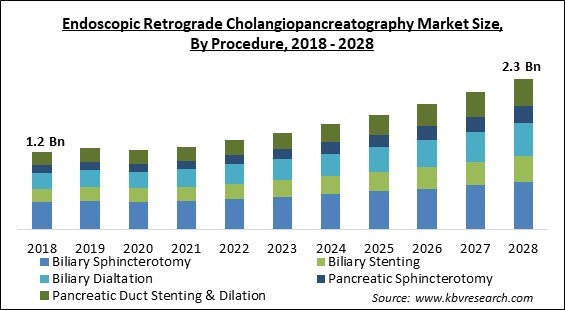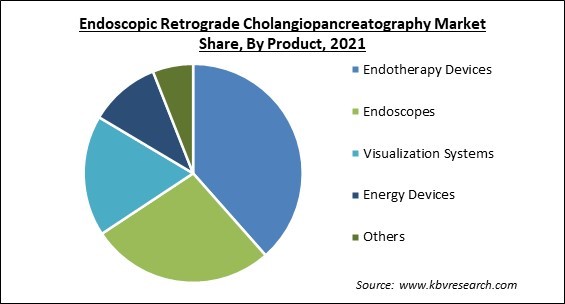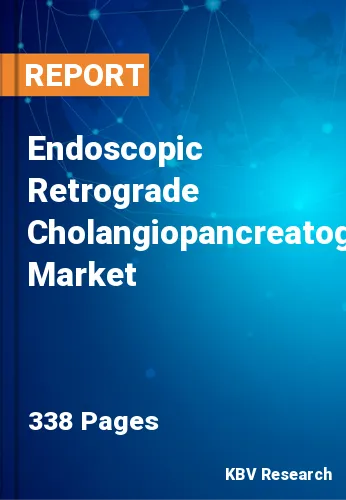The Global Endoscopic Retrograde Cholangiopancreatography Market size is expected to reach $2.3 billion by 2028, rising at a Market growth of 9.1% CAGR during the forecast period.
Endoscopy is a medical procedure that allows doctors to examine body tissue or internal systems with complete precision or perform small surgeries. Endoscopic retrograde cholangiopancreatography (ERCP) is a medical procedure used to treat and diagnose abnormalities of the pancreas and biliary system. Due to an increase in the prevalence of various pancreatic, bile duct, and liver abnormalities such as Pancreatitis, Barrett's esophagus, liver disease, Biliary Disease, Crohn’s Disease, Gastroesophageal Reflux Disorder (GERD), Colitis, Inflammatory Bowel Disease, Crohn's Disease, and Peptic Ulcer Disease, this procedure is gaining significance and being widely adopted.
Tissue sampling or treatment of diseases of the bile duct or pancreatic duct system, obstructive jaundice, unexplained pancreatitis, suspected pancreatic cancer, nasal drainage, Sphincter Oddi manometry, and bile duct stent are among the indications for the use of endoscopic retrograde cholangiopancreatography (ECRP) devices. For pancreatic pseudocyst drainage, ductal stenosis, and balloon dilation of the papilla of Vater, as well as leakage and stenosis.
For the diagnosis and treatment of pancreatobiliary system-related illnesses, endoscopic retrograde cholangiopancreatography (ERCP) devices combine fluoroscopic imaging and luminal endoscopy. The device employs a side-view duodenoscopy that is inserted via the esophagus and stomach through the duodenum's latter region. The majority of endoscopic retrograde cholangiopancreatography (ERCP) devices are used to collect tissue and cell samples or to treat a blocked pancreatic or bile duct.
The utilization of endoscopic retrograde cholangiopancreatography (ECRP) devices for cancer treatment has grown in popularity over time. The rising frequency of benign liver and pancreatic tumors is expected to provide favorable Market conditions for endoscopic retrograde cholangiopancreatography (ECRP) devices manufacturers in various countries.

The COVID-19 pandemic has triggered a global emergency. The infection is more likely to impact surgeons and patients who regularly attend hospitals for various procedures. The majority of gastrointestinal operations were suspended, resulting in a drop-in device-based treatments like ERCP. In hospitals across Germany, approximately 40–50% of endoscopic procedures were postponed or canceled. According to a study, the COVID-19 pandemic resulted in a considerable reduction in ERCP procedures. Due to the reduction in endoscopic services across the world, the success rate of the treatment was also dropped. COVID-19 had a negative effect on the ERCP Market . Additionally, endoscopy is classified as an aerosol-generating technique, posing a danger of transmission to healthcare workers.
Endoscopic retrograde cholangiopancreatography (ERCP) is a technique for diagnosing and treating pancreatobiliary system diseases that combines luminal endoscopy with fluoroscopy imaging. It combines X-ray with an endoscope, which is a long, flexible, and illuminated tube. ERCP can be used to figure out undetected abdominal pain or skin and eye yellowing caused by jaundice. It can be used to figure out if patients have pancreatitis or cancer of the liver, pancreas, or bile ducts. Obstructions or stones in the bile ducts, as well as liquid leakage from the bile or pancreatic ducts, can be identified by Endoscopic Retrograde Cholangiopancreatography (ERCP).
Gastrointestinal illnesses impact several portions of the GI tract as well as digestive organs such as the liver, pancreas, and gallbladder. Gastrointestinal illnesses diseases affect millions of people around the world and are a leading cause of morbidity and mortality. According to a report issued in 2019 by the International Foundation for Gastrointestinal Disorders, GERD affects nearly one-third of the global population, resulting in bleeding difficulties, which drives the Market . Primary biliary cholangitis (PBC), has a frequency of 5.8-15 cases per million people. Governments' attention has been called to a significant increase in fatality rates.
The high prices of ERCP technologies and procedures are among the most significant Market restraints. The average cost of a regular endoscopic ranges cost higher than the other procedure whereas the HD variant of the HD endoscopic cost more than regular procedure. As per ERCP experts, one of the main reasons why the treatment is not easily accessible and affordable is because many small-scale end customers serve a big population, particularly in developing nations. The endoscopic procedure are highly risky, which requires professional doctors and surgeons for the treatment which automatically boost up the cost of the procedure.

Based on Procedure, the Market is segmented into Biliary Sphincterotomy, Biliary Stenting, Biliary Dialatation, Pancreatic Sphincterotomy, and Pancreatic Duct Stenting & Dilation. The Biliary sphincterotomy segment procured the largest revenue share in Endoscopic Retrograde Cholangiopancreatography/ERCP Market in 2021. Biliary sphincterotomy (EST) is the process of cutting the biliary sphincter and intraduodenal portion of the common bile duct using a high frequency current and a specific knife called a sphincterotome inserted into the papilla after selective cannulation. Biliary sphincterotomy is usually done as part of an endoscopic retrograde cholangiopancreatography (ERCP) procedure to help with further procedures or as a standard treatment for bile leak. These factors are boosting the growth of this segment of the Market .
Based on Product, the Market is segmented into Endotherapy Devices, Endoscopes, Visualization Systems, Energy Devices, and Others. Based on Endotherapy Devices Type, the Market is segmented into Stents & Sphincterotomes, Catheters, Lithotripter, Cannulas, Forceps, Snares, Guiding Wires, Balloons, and Others. The Endoscopes devices garnered the substantial revenue share in the Endoscopic Retrograde Cholangiopancreatography/ERCP Market in 2021. Endoscopy devices are equipped with camera or light source at the tip of the endoscope to assist practitioners in analyzing internal organs of interest. Endoscopy can be used to explore digestive system symptoms such as vomiting, nausea, swallowing difficulties, abdominal pain, and gastrointestinal hemorrhage. Due to improvements in technologies, the endoscopy devices Market is expected to grow significantly over the forecast period.
Based on End user, the Market is segmented into Hospitals, Ambulatory Surgery Centres & Clinics, and Others. The Hospitals segment acquired the highest revenues share in the Endoscopic Retrograde Cholangiopancreatography/ERCP Market in 2021. Rising demand by patients for therapy in hospitals utilizing devices such as sphincterotomes, as well as superior preventative care and treatment alternatives in clinics, is fueling the growth of the segment. Moreover, this increase is also due to the rapid expansion of healthcare infrastructure in the various regions, which has aided hospital financial development.
| Report Attribute | Details |
|---|---|
| Market size value in 2021 | USD 1.3 Billion |
| Market size forecast in 2028 | USD 2.3 Billion |
| Base Year | 2021 |
| Historical Period | 2018 to 2020 |
| Forecast Period | 2022 to 2028 |
| Revenue Growth Rate | CAGR of 9.1% from 2022 to 2028 |
| Number of Pages | 339 |
| Number of Tables | 540 |
| Report coverage | Market Trends, Revenue Estimation and Forecast, Segmentation Analysis, Regional and Country Breakdown, Companies Strategic Developments, Company Profiling |
| Segments covered | Procedure, Product, End User, Region |
| Country scope | US, Canada, Mexico, Germany, UK, France, Russia, Spain, Italy, China, Japan, India, South Korea, Singapore, Malaysia, Brazil, Argentina, UAE, Saudi Arabia, South Africa, Nigeria |
| Growth Drivers |
|
| Restraints |
|
Based on Regions, the Market is segmented into North America, Europe, Asia Pacific, and Latin America, Middle East & Africa. The North America region, procured the highest revenue share in the Endoscopic Retrograde Cholangiopancreatography/ERCP Market in 2021. As the incidence of cancer rises, hospitals are investing heavily on modern ERCP technology. and a significant concentration on research actions to improve endoscopic techniques are all important factors propelling the growth of the ERCP devices.
Free Valuable Insights: Global Endoscopic Retrograde Cholangiopancreatography Market size to reach USD 2.3 Billion by 2028
The Market research report covers the analysis of key stake holders of the Market . Key companies profiled in the report include Olympus Corporation, Fujifilm Holdings Corporation, Ambu A/S, Boston Scientific Corporation, Steris PLC, Johnson & Johnson, B. Braun Melsungen AG, ConMed Corporation, Medtronic PLC, and Karl Storz SE & Co. KG.
By Procedure
By Product
By End User
By Geography
The global endoscopic retrograde cholangiopancreatography market size is expected to reach $2.3 billion by 2028.
Rise in gastrointestinal and chronic biliary illnesses are increasing are driving the market in coming years, however, high cost of the procedure growth of the market.
Olympus Corporation, Fujifilm Holdings Corporation, Ambu A/S, Boston Scientific Corporation, Steris PLC, Johnson & Johnson, B. Braun Melsungen AG, ConMed Corporation, Medtronic PLC, and Karl Storz SE & Co. KG.
The expected CAGR of the endoscopic retrograde cholangiopancreatography market is 9.1% from 2022 to 2028.
The Spa & Relaxation segment acquired the maximum revenue share in the Global Endoscopic Retrograde Cholangiopancreatography Market by Industry in 2021; thereby, achieving a market value of $315.8 million by 2028.
The North America is the fastest growing region in the Global Endoscopic Retrograde Cholangiopancreatography Market by Region in in 2021, and would continue to be a dominant market till 2028.
Our team of dedicated experts can provide you with attractive expansion opportunities for your business.

